The Turkish Navy: Controlling the Bosporus
At the end of the Treaty of Sèvres concluded by the victorious powers with Greece and Turkey (traditonal rivals of the Balkans) the Turkish navy, allied with the Germans was to be reduced to a coastal force, a status far from past ambitions and glory, but true to current economical situation.
Above all, the allies demanded the return of the battle cruiser Yavuz Sultan Selim, the former German SMS Goeben taking refuge into Turkey in August 1914 and remained the last of the great modern German battleship after the Hochseeflotte scuttling in 1919. On one hand she was the best card in Ankara’s hand, but it was also seen as a threat to peace and naval balance in the region.

Colorized photo of the Yavuz in 1945, by Hirotoko Jr.
With the attempted takeover of Mustapha Kemal, revivified Turkish nationalism provoked internal disturbances and a cooling in relations with Greece, going as far as the expulsion and deportation of Greeks living in Asia Minor, and mediatic sack of Smyrna. The civil war against the ruling dynasty dragged on until 1922, and by that time, the Turkish fleet was under the control of the Americans, British and French.
In July 1922, peace was signed after the departure of the Sultan, authorizing the allies to negotiate a new treaty with the freshly installed government of Mustapha Kemal. Kemal was determined to keep the fleet, and his new position meant that he negotiated through tonnage reduction the destruction of obsolete units, but was still allowed to keep a small defensive naval force.
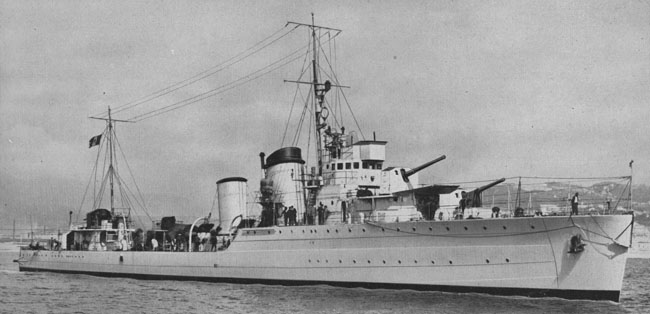
The Italian-built destroyer Tinaztepe (without markings), freshly out from CT Riva, Trigoso naval yard, flying the Regia Marina tricolor. sec: naviearmatori.net
Above all, the Yavuz was preserved, becoming the mainstay of this new fleet. However the budget allocated was still very thin, and the program really began in 1926. The goal was to create a strong defensive force, able to block the Dardanelles with mines and submarines, but with a more active component, a task force made of the unique Yavuz as capital ship and four destroyers. It included the modernization of the oldest units, and the construction of two first submersibles.
One of the key aspects for which Turkey was still courted by diplomatic cells, was its control over the straits, effectively locking the black sea. This was restricted by the 1923 Treaty of Lausanne, demilitarizing Turkey under the assumption that treaties under the League of Nations would keep the peace locally. But the failure of the latter soon trigerred a Turkish rearmament and some defiance towards the former entente power.
Relations with Germany
These were the German-designed “N° 1” and “N °2”, built in Fijenoord, Holland. The new Turkish government indeed renewed its confidence to the old northern ally. After these, Turkey ordered five more, built in Spain or Turkey, and lately directly in Germany, before swapping when the war broke out, to the British.
Attitude towards the Italians
The Turks also trusted the Italians for destroyers, and the latter will deliver to them four destroyers and two additional submersibles, as well as MAS torped boats. In fact Fascism and Kemalism were both driven by an extreme nationalism and Mussolini regime had some strong influence over the new regime, whereas relations were tense at first. After all, not long before WW1, Turkey and Italy has been at war. The rapprochement followed the consolidation of the Kemalist regime was compounded by Italy’s attempt to build an alliance with Greece and Turkey to counterweight French influence in the Balkans from 1926 to 1931. However these attempt failed and relations became tense again until 1939.
1936: Renegociation of the Lausanne treaty
In 1936, Turkey called a conference in Montreux (Switzerland) to renegotiate the Treaty of Lausanne. The Montreux Convention established that non-littoral states were allowed restricted naval passage whereas Turkey was at least free to defend the straits in wartime or in the case of any impending threat. Soviet Russia could access the Mediterranean only with Turkey’s permission, wgiving the capitalist nations of the west some control over Soviet expansion.
Change towards the allies
The British were contacted to provide patrol launches, supplying also destroyers (all requisitioned as well as submarines), released when possible from 1942 to 1945. By that time, more orders came, this time for HDML and Fairmile launches in relatively large quantities.
In 1942-45, the British transferred some thirty light units indeed, hoping a Turkish engagement on the side of the Allies, even late into the war. These transfers took place under the personal insistence of Churchill, always aiming at the “soft belly of the Reich”. On the other hands, Turkish diplomatic relations with Berlin had strained since August 1944 and confrontation with the Greeks never happened.
The Turkish Fleet in 1939
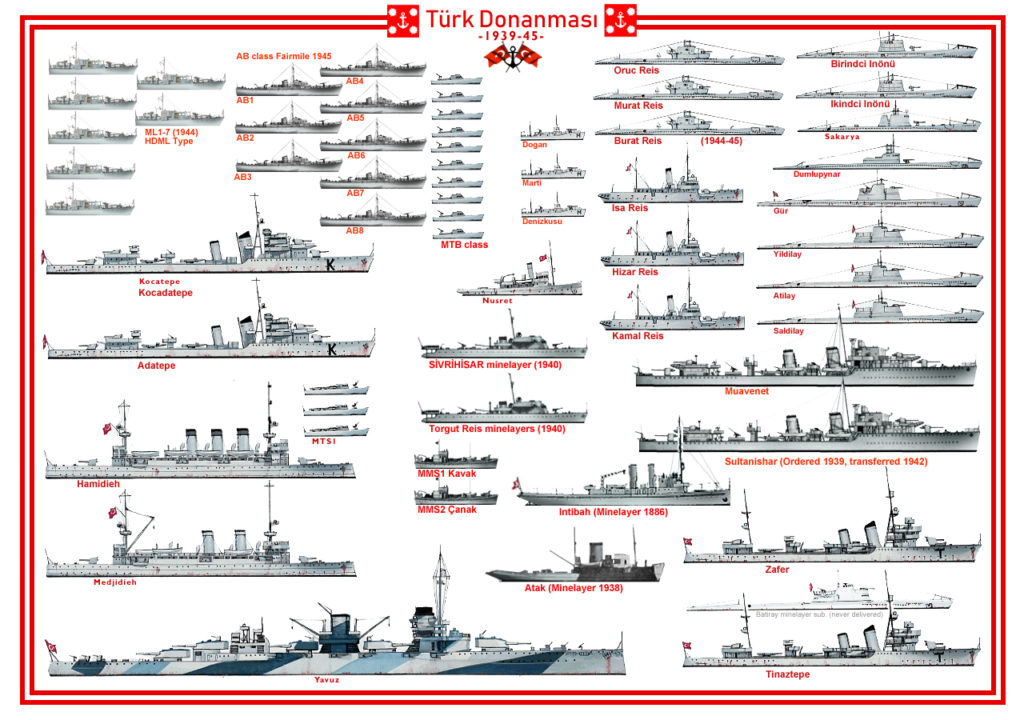
1 Battleship:
The mainstay of the Turkish fleet was obviously the formidable Yavuz, modernized in France in the 1930s, which despite its guns of a limited caliber retained great firepower, high speed and good protection. The very venerable battleship Torgud Reis, formerly Wissembourg, a pre-dreadnought of 1891 was listed still as coastal battleship, but reached the ultimate limit of her life span and was classed as a pontoon since 1924, BU 1938.
2 Cruisers:
Hamidieh and Medjidieh, dating from 1903, were retained as a training ship. They were perfectly operational as minelayers in case of conflict.
src: http://www.historyofwar.org/Pictures/hamidieh.jpg
4 Destroyers:
Little homogeneity but a succession of classes of recent ships of Italian origin (Kocatepe and Tinaztepe). There were no others in service, the oldest being broken up in the 1930s. On the other hand an order of four destroyers was passed to Great Britain in 1938, copies of the “H” class. Two were obtained in 1942 after negociations, Sultanishar and Demihishar.
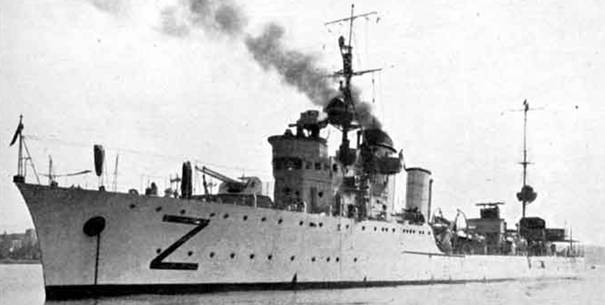
Zafer 1932
They were requisitioned before completion at the beginning of the war, and only two will be later attributed to Turkey in 1942, the other two being pressed into service with the RN: The two Sultanishar. The ex-Muavenet (), and Gayret (HMS Ithuriel) were obtained by Turkey on 1945 as contracted, but the second wa slost in operation during Operation Torch.

8 Submersibles:
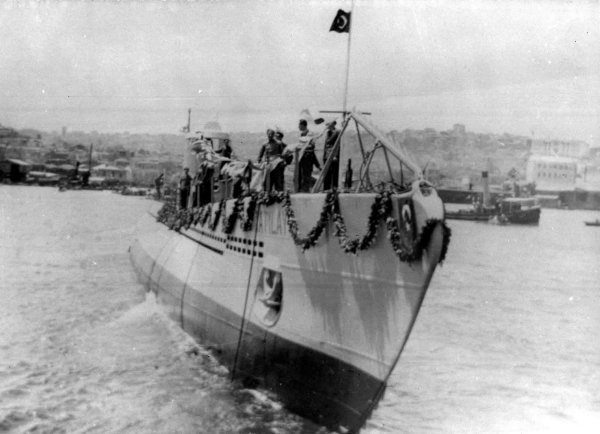
Atilay 1939
In 1939, the Turkish fleet could count on a force of 9 submersibles, units of almost all-German origin, but officially Dutch (both Birindci), Spanish (Gür), and at last officially German for the three Atilay, the Batiray (requisitioned) before placing orders to Great Britain for four other S-classs in 1939 (Burac Reis class) requisitioned and retroceded with a British crew in 1942. One of them was saunk in action in 1943. The remainder third joined in the fleet by 1945.
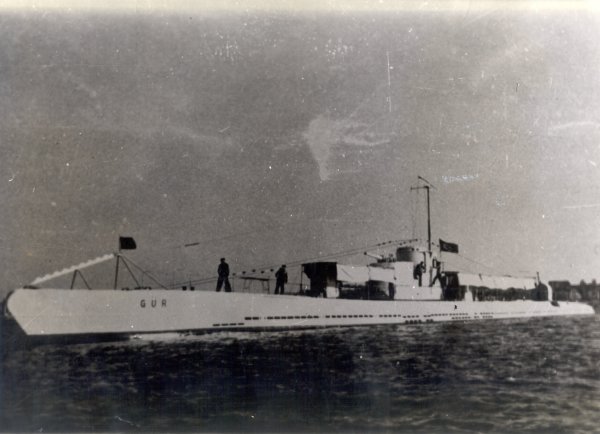
15 Miscellaneous ships:
The Turkish Navy finally operated a panel of light units, including MAS torpedo launchers of the Dogan class, and Kavak MTBs of British origin and minelayers. In 1942 Turkey ordered and received ten more modern British torpedo launches, and towards the end of the war, in addition from the Royal Navy, seven HDML patrol boats and eight ML-type Fairmile launches in 1944-1945.
However the fleet was also reinforced by three recent minelayers (Atak and the two Shivrishar class), and 8 older, the two (modernized) Berkistavets, the four Aidan Reis, the Nusret and the obsolete Intibah (1886).
Tonnage: Battleships: 1 – Cruisers: 2 – Destroyers: 4 – Submersibles: 8 – Misc.: 15
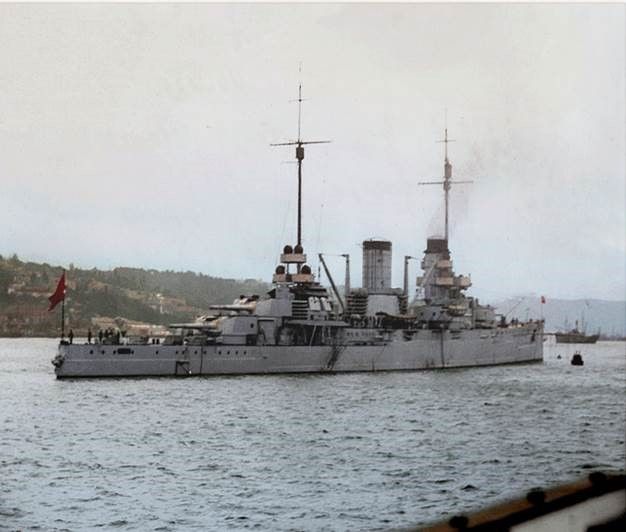
Battleship Yavuz in 1931
War operations:
Turkey was part of the Balkan Entente (Romania, Yugoslavia, Greece, Turkey), neutral when France was invaded in 1940. In June 1941 with the German invasion of the Balkan Peninsula, a non-aggression pact was signed, giving Turkey a sense of security. On the other hand, this also secured the flank of the upcoming invasion of the Soviet Union for Germany. On 3 Nov 1941, the Turkish schooner Kaynakdere was sunk by Soviet submarine ShCh-214 in the Black Sea. The schooner indeed was spotted sailing in an area controlled by German troops and suspected smuggling in supplies. Other Turkish vessels were sank for the same reasons by Soviets.
On the other hand, in July 1942 the Turkish merchant ship Antares was sank by error by the Italian submarine Alagi. Just prior to WW2, as the ituation in the Mediterranean was dire for the allies, both Churchill and Rooselevlt opened a seduction operation towards the Turks: In the first days of December 1941, Franklin D. Roosevelt announced the eligiblity of Turkey to receive Lend-Lease aid.
Later with the capitulation of Italy and Germany’s more desperate defensive stance, Turkey started effectively a rapprochement to the Allied side. They halted chromite exports to Germany (a stainless steel component) in April 1944 and in August, severed diplomatic relations completely. In February 1945, Turkey attended the inaugural meeting of the United Nations and eventually declared war on Germany on 23 February 1945.
This late entry would not have allowed the Turkish fleet any serious test. The German threat in the Black Sea or the Mediterranean was no longer relevant, although in the Black Sea, the Turks could operate against the remnants of the Romanian Navy under German control still operating. The Turks will not record any loss nor win however, being largely passive. But the move was to ensure a good treatmentwarmed qute quickly in the post-war environment, perhaps not anticipating the future east-west confrontation.
Indeed Turkey would become during the cold war, and especially the early period a hotbed of tensions and spy activities, stuck in between the USSR and the Western world. In the first years of post-war Europe, Stalin indeed tried to compromise the Montreux Convention and already made plans for Turkey’s northeastern provinces. The threat was well understood by the West and Turkey soon approached its Western allies to be quickly granted access as a full member of NATO in 1952 (Germany was still out of it at that stage). The cold war warmed quickly when the US decided to deploy Jupiter ballistic missiles in Turkey in 1961 (there were bases already). It was seen as a direct threat as the doorsteps of Soviet strategic assets (such as the naval base of Sebastopol and black sea fleet) and provoked the installation of missiles in Cuba, with the consequences we know…

And now the what ifs.
Turkey on the axis side
-What if Turkey joined the axis during ww2? Before Operation Barbarossa, such a fleet could have launched an operation on Cyprus, settling an old account with Greece and depriving UK of a precious base, from where it could operate against British and French interests in the region, which were many. However it would have not hampered convoys, which came from the west by the southern route of Sicily, and the eventuality of an amphibious assault was unlikely for Turkey which was ill-prepared for the task, unless helped by the Italians (…).
After Barbarossa in 1941, however, the Turkish fleet could have seriously hurt Soviet interests in Crimea, deploying minefields, probing the area and disrupting convoys with submarines, and prey on installations and convoys with its “task force” around the Yavuz.
Operations could also include a precious help to the Romanian Navy in landings or evacuations. However this is an agressive stance and it’s possible also th Turkish fleet would have been just stationary at Istambul to prevent any passage through the Dardanelles.

Turkey on the allied side
-What if Turkey joined the allies early in the war ? Perhaps on one part, RN ships ordered could have joined sooner the fleet, and the addition of Lend-Lease in 1941-42 would have provided more ships, notably destroyers, perhaps even a cruiser or two. The RN did no lacked second-rate modernized ww1 era cruisers by that stage to distribute to her allies.
Reinforced that way, the Turkish fleet would have either patrolled along the Mediterranean sector approaching the Dardanelles, could have helped in some ways British and Greek troops in the Balkans although it’s unlikely due to old rivalry, and more likely would have been precious in disrupting the axis moves in the Black sea, which became an “axis lake” during the war, crippling the Soviet black sea fleet. The Romanian fleet was not a match for the Turks even not reinforced by the allies, and the Germans could not provide much support in the region but the luftwaffe. Turkish ships of the interwar generation however lacked AA, which balanced this superiority.
But an allied mastered black sea would have meant a possible diversionary grand scale landing on the weak flank of the German group south by the sea, seriously hurting the axis advance in this sector. Perhaps even the battle of Stalingrad would have never happened. But it’s worth noting the Soviet Navy was inexperienced and not equipped for amphibious assaults, and did not have the mastery of the skies.
But if a combined allied attack in that sector was more difficult because of the distance from the only bases available, Malta and Alexandria, it could have been unlocked if Istanbul could be used. It could have cut out the open southern rear flank of the Wehrmacht, starting with the weaker Italian and Romanian divisions, and combined with the Red Army, operating a large turning movement to the axis rear, encircling units and eventually racing towards the baltic. This would have left the Wehrmacht time to retreat in good order in Prussia, abandoning most of its Russian acquisitions. This could have deep-reaching effect on the morale of the army and a disaster of a magnitude difficult to hide to the population. The war could have ended much sooner, in 1943.
Read More/Src
John Gardiner’s Conways all the world’s fighting ships 1906-21, 1922-46
on nusratmayingemisi.com
on laststandonzombieisland.com
journals.openedition.org/diacronie/
on turkishnavy.net/
oryx/spioenkop article on Turkish German subs
on fpri.org/
Turkish Navy ships, in detail
 Battlecruiser Yavuz (1914)
Battlecruiser Yavuz (1914)

Certainly by far the most impressive ship of the Turkish Navy, Yavuz, contracted from Yavuz Sultan Selim was formerly the Goeben of the Hochseeflotte, detached in 1914 in the Mediterranean squadron based in Port Said in Egypt. On the night of August 14, 1914, the telegraphist received from Germany the warning for imminent conflict. Admiral Souchon, awakened, did not wait to fall on allied ships in the harbor itself or a few miles to Alexandria, and had two ships, the Goeben, and light cruiser Breslau. Souchon had only three alternatives and chose the shortest escape route in Constantinople. The ships were donated to the Turkish authorities after negociations with the Kaiser to joint the Central Empires. Indeed the Turkish admiralty knew all too well to be singularly ill-equipped to support a naval conflict against Italy, Greece and Russia. The Geran crews remained on board and Souchi became commodore of the Ottoman Navy, leading many operations in the Balck sea.
Renamed Yavuz Sultan Selim, Midilli (Breslau) led several actions aganist the Black Sea fleet (see the full article), and her firepower and qualities made her a formidable adversary and a master asset in this area for the triple alliance. Yavuz was immobilized at the end of the war in Constantinople, waited for his fate. After negociations she was not to be interned like the rest of the Hochseeflotte, once her crew returned to Germany. Negotiations went well, the Turks having done everything to preserve her. Unofficially, no doubt, against territorial compensations, and no doubt also because the allies thought that Turkey would be unable to maintain it properly, the sublime door was allowed to keep its flagship. De facto, after the Scapa Flow 1919 scuttling, Yavuz became effectively the only German battle cruiser still afloat. He was the only one in the world to be part of this very exclusive club also including Hood and the Repulse pair. In 1927, she was sent to Izmid to modernize fire control with equipments and assistance from the French La Seyne-Penhoet Yards. The machines were upgraded to oil-firing, and Yavuz was capable of 27 knots after trials.
In 1936, her appearance changed little, if not in details, the Yavuz Sultan Selim simply became Yavuz. In 1938, a new and very partial modernization took shape, cosmetic, and in 1941 the greatest changes took place: Its rear mast was removed for reasons of stability because at the same time its anti-aircraft batteries were brought to 12 pieces of 40 mm and 4 of 20 mm. He was camouflaged, but Turkey remained neutral and the Yavuz was quite inactive.
In 1945, when Turkey finally officially went to war with the allies, Yavuz made some operational sorties, still a fast ships with batteries of 280 mm. She would remained in service again during the cold war until 1971, but as a training ship, still pride of the Turkish navy for 30 years. At that date, it was decided to scrap her.
Specifications
-Displacement: 15 900t, 17 600t FL
-Dimensions: 186 x 12.30 x 6.28 m
-Propulsion: 2 shafts Parsons turbines, 35,000 hp. and 27 knots max.
-Armour: ?
-Crew: 670
-Weaponry: 12 guns of 280 mm, 12 guns of 120, 12 guns of 40 mm Bofors AA, 4 of 20 mm AA, 4 TLT 533 mm SM.
 Medjidieh class Cruisers (1906)
Medjidieh class Cruisers (1906)

Medjidieh and Hamidieh, although classified as different ships, were very close. Designed on British plans and built elsewhere in Britain, they were perfect examples of export cruisers bearing the brink of Armstrong-Eltswick shipyards. At that time, they were still the pride of a navy formerly powerful and which counted mainly in its ranks that ancient battleships of the nineteenth century reconverted into floating batteries. Painted in khaki green, the livery of the Turkish ships in 1914, they participated in various operations in the Black Sea, but did not intervene against the fleet allied to the Dardanelles.
Specifications
-Displacement: 1206t, 1610t FL
-Dimensions: 96 x 9.30 x 3.28 m
-Propulsion: 2 shaft Parsons turbines, 35,000 hp. and 36 Knots max.
-Armour: Crew 149
-Armament: 4 x 120 mm, 2 x 40 mm Bofors AA, 2 x 20 mm AA, 6 x 533 mm TTs.
 Kocatepe class Destroyers (1931)
Kocatepe class Destroyers (1931)

Built in Genoa (Ansaldo), these two units (Adatepe and Kocatepe) were generally inspired by Italian standard destroyers, but with four simple turrets instead of doubles, requiring dedicated deckhouses and lengthening the length of these ships, and two fireplaces. instead of a. For the rest, they were fast, flawless marine vessels. They participated in some patrols in 1945 and continued their service until about 1955.
Specifications
Displacement: 1250t, 1650t FL
Dimensions: 100,20 x 9,37 x 2,90 m
Propulsion: 2 shafts Thornycroft turbines, 40,000 hp, 16 knots.
Crew: 149
Armament: 4 x 120 mm, 2 x 40 mm Bofors AA, 2 x 20 mm AA, 6 x 533 mm TTs.
 Tinaztepe class Destroyers (1931)
Tinaztepe class Destroyers (1931)
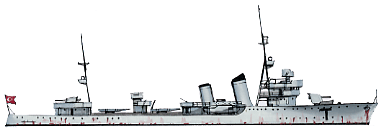
The Tinaztepe and the Zafer were built at the Riva shipyard in Trigoso in addition to the Kocatepe. They were inspired directly by Freccia’s plans, but their chimney ducts emerged separately. They could also anchor mines and had a less active career, apart from a few sorties in 1945 in a Mediterranean furrowed by Allied ships. They were scrapped in 1957.
Specifications
Displacement: 1206t, 1610t FL
Dimensions: 96 x 9.30 x 3.28 m
Propulsion: 2 shaftsParsons turbines, 35,000 hp. 36 knots max.
Crew: 149
Armament: 4 x 120 mm, 2 x 40 mm Bofors AA, 2 x 20 mm AA, 6 x 533 mm TTs.

Translated as “Number 1 and 2”, the Birindci and Ikindci were submersibles studied by the Germans at the Hague office (and built in Fijenoord). These were buildings inspired by the UB of 1917, much improved. Designed in 1925, they were delivered in 1927. Oceanic, powerful, they plunged up to 150 meters and spun 8.5 knots under water. They will be demolished in 1955-56.
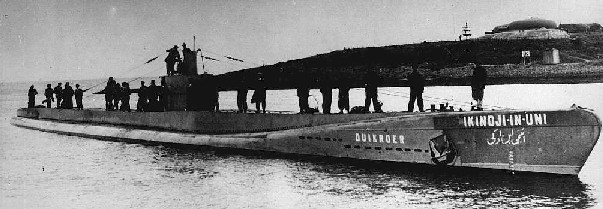
Specifications
Displacement: 505t, 620t surf./sub.
Dimensions: 58.68 x 5.80 x 3.50 m
Propulsion: 2 shafts 2 MAN diesels, 1100/700 hp. surf./sub 13,5/8,5 knots.
Crew: 29
Armament: 1 x 75 mm gun, 1 x 20 mm AA, 6 x 450 mm (4 bow, 2 stern) TTs.
 Sakarya (1931)
Sakarya (1931)

Other Submersible built in Italy but inspired this time from the Argonauta. It was a coastal, and also equipped with German diesels. She was remarkably fast in diving (10 knots on trials).
Specifications
Displacement: 710t, 940t surf./plong.
Dimensions: 59.74 x 6.80 x 3.96 m
Propulsion: 2 shafts MAN diesels, 1600/1100 hp. surf./sub. and 16.9/9.5 knots.
Crew: 41
Armament: 1 x 100 mm, 1 x 20 mm AA, 6 x 450 mm TTs (4 bow, 2 stern).
 Gür (1931)
Gür (1931)

Gür was a submersible studied by the Germans for the Spaniards. It was built in Echovarietta Y Larringa in the Basque country, but the Spanish sold it in 1934 to Turkey. it was the brilliant draft of U-Bootes type IA. Oceanic, these units boarded 14 torpedoes and spun 20 knots on the surface, and relied on 6400 nautical, which made it a perfect raider. He will be disarmed in 1957.
Specifications
Displacement: 750t, 960t surf./sub.
Dimensions: 72.42 x 6.20 x 4.11m
Propulsion: 2 shaft diesels MAN, 3800/1000 hp, surf./sub. 20/9 knots.
Crew: 42
Armament: 1 x 100 mm, 1 x 20 mm AA, 6 x 533 mm TTs (4 bow, 2 stern).
 Atilay (1938)
Atilay (1938)

Gür having impressed the Turks, they directly ordered three other units to Germaniawerft German shipyards in Kiel, which at the time no longer moved anyone: The Anglo-German naval agreement had definitively buried the prohibitions resulting from the treaty from Versailles. The Yildilay was however built in Istanbul.

The other two, Atilay and Saldilay, were issued in 1939. They were derived from U-Bootes type IXA, but had their cannon under shield. They plunged more than 100 m operationally, but their strength allowed them to go down more than 200 meters and withstand the pressure. The Atilay was lost in 1942, not in combat but in exercises: He sank with all his crew. The other two were scrapped in 1957.
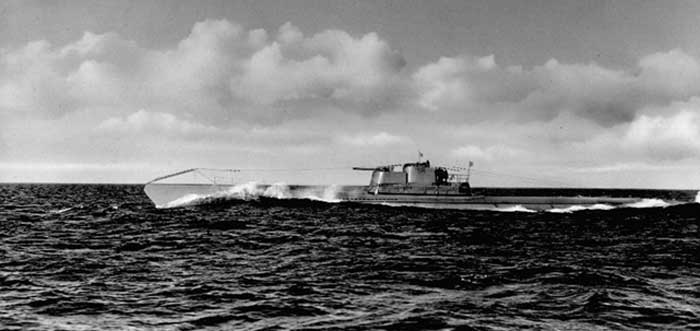
 Batiray (1939)
Batiray (1939)

Batiray was a large minelayer submersible ordered from Germaniawerft, Kiel. She was a study of the type for the Kriegsmarine under cover of a Turkish order, and was in effect, never delivered to the Turks, the Germans requisitioned her in September 1939, just after completion. The minelayer submersible was renamed AU and operated in the Baltic and Norway until 1945 under German flag. She was scuttled to avoid capture on May 3, 1945.
Specifications
Displacement: 934t, 1210t surf./sub.
Dimensions: 80m x 6.40m x 4.26 m
Propulsion: 2 shafts 2 diesels B & W, 3500/1000 hp. surf./sub. 20/9 knots.
Crew: 44
Armament: 1 x 100 mm, 1 x 20 mm AA, 4 x 533 mm TTs (4 bow), 20 mines.
 Oruc Reis class (1940)
Oruc Reis class (1940)

The Turks ordered four Submarines to British yards (presumably to give the change after having largely ordered to the axis, Italy and Germany, and to prove its neutrality). They were of famous “S” type. The class comprised the Burac, Murat, Oruc and Ulac Ali (Reis), laid down at Vickers-Armstrong before the war. They were all requisitioned in 1939 by the Royal Navy.
The Turks waited until 1942 to see the return of the first two of this initial order, the Oruc and Murat, ex-P 612 and 611 and the third, Burat Reis in 1945, manned by British crews. They will be disarmed in 1957. P615 (ex. Oruc Reis) was sunk by U-123 in the Atlantic in August 1943.
Specifications
Displacement: 624t, 861t surf./sub.
Dimensions: 61.78 x 6.78 x 3.20 m
Propulsion: 2 shaft Vickers diesels, 1550/1300 hp. surf./sub. and 13.75/10 knots.
Crew: 40
Armament: 1 x 76 mm, 1 x 20 mm AA, 5 x 533 mm TTs (4 bow, 1 stern).
 Isa Reis class Minesweepers (1912)
Isa Reis class Minesweepers (1912)

Three units built in 1911-12 whuich served as gunboats in 1914-18, and were converted in 1938 into minesweepers (Hizar Reis, Isa Reis and Kemal Reis). They operated until 1947-48. Other comparable gunboats had been scrapped in 1925-26, the Burak, Sakiz and Prevezah. Their sister ship of 1912, the Aiden Reis had been transformed into a fishery guardship.
Specifications
Displacement: 364t, 1610t PC
Dimensions: 96 x 9,30 x 3,28 m
Propulsion: 2 propellers, 2 Parsons turbines, 35,000 hp. and 36 Nodes max.
Crew: 149
Armament: 4 x 120 mm, 2 x 40 mm Bofors AA, 2 x 20 mm AA, 6 x 533 mm TTs.
 Other Minesweepers (1912-1940)
Other Minesweepers (1912-1940)
Nusret (1912) and Intibah (1886) were high-sea tugboats converted to minelayers. They made both world wars and were scrapped in 1957.
Intibah had a very long career since she was rebuilt as a minelayer later (she was also much larger than the Nusret (616 tons)). She was renamed Uyanik in 1942 and finally broken up in 1957. Additionally the fleet was completed by SS Kiresund, an old civilian freighter of 3056 GRT (1877) converted and in service during the Great War but scrapped in 1927.
More modern was the Atak (1938), built at Gölcük, a 500 tons ship, 43.99 m long (144 feets), with a 1025 hp VTE, 13 knots, carrying 40 mines, and the Sivrihisar class (1940) built at Thornycroft (& Torgud Reis), 350 tons, 52.45 m long (172 feets), 1200 bhp and 15 knots, 40 mines and a QF 75 mm gun (3 in).
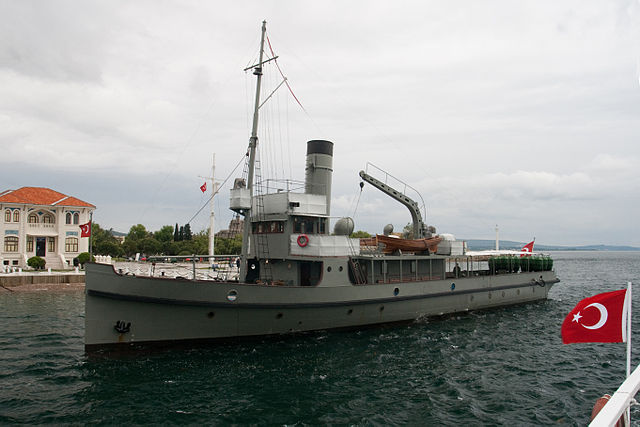
The Kaptan Nusret (lost 1989) was salvaged in 2002 and restoration ended in 2008.
The Nusret was the most famous Turkish minelayer. Originally a German tug, purchased before the war. She was converted during WW1 and famously operated during the Gallipoli Campaign. During the early naval phase when the combined French-British fleet bombarded the inner forts of the Dardanelles, the Turks observed the path taken by the battleships and the Nusret sailed to the area by night to lay mines just at the tight spot.
The following day, the battleships were back. The small Nusret’s mines would make a carnage on the old pre-dreadnoughts, with limited ASW protection. The Turkish ship claimed that day the battleships HMS Irresistible, HMS Ocean and Bouvet, and sending the Battlecruiser HMS Inflexible crippled in a dockyard for almost a year.

The losses were so horrendous (until then the combined fleet did well against the forts) that the allied Admiral decided to draw a close to the naval operation, trigerring the landings, with the results we know. The Nusret (Or Nusrat) was renamed Yardım in 1937 used as a diving vessel, and Nusrat again in 1939 as a tender, then Kaptan Nusret in 1966 until she sank in April 1989 off Mersin Harbour. She layed at the bottom for ten years before being salvaged and overhauled, restored in her 1915 appearance and now in the çanakkale museum.
Specifications (Nusret)
Displacement: 364t, 1610t FL
Dimensions: 96 x 9.30 x 3.28 m
Propulsion: 2 propellers, 2 Parsons turbines, 35,000 hp. and 36 Nodes max.
Crew:149
Armament: 4 guns of 120 mm, 2 guns of 40 mm Bofors AA, 2 of 20 mm AA, 6 TLT 533 mm.
 Turkish Launches & MTBs (1926-42)
Turkish Launches & MTBs (1926-42)

Capable MTBs in service in the Turkish Navy were the three Dogan class boats, MAS types, bought from the Italians in 1931 and built by SVAN yard. In the old fashioned way, they had a slightly raised prow and two torpedoes launching from the stern with compressed air, 450mm aviation torpedoes.
They also had a shielded 75 mm QF gun, and 8 ASW grenades. These 32-tonnes ships could reach 34 knots, thanks to their two powerful Isotta Fraschini engines delivering 1500 hp total. The class consisted of Dogan, Marti and Denizkuzu. They were removed from the lists in 1947-48.
The two Kavak (Kavak, Canak) were of the HDML type (diesel patrol boats) ordered from Thornycroft and issued in 1939. These ships were capable of 15 knots but were not equipped with any weapons and only used for patrol.
The 10 Thornycroft MTB type (MTB-1-9), built in Turkey on plans by Thornycroft arrived in 1942. The latter barely deserve the title of launches, since they only reached 10 knots.
These 70-ton vessels had a combined 2000 hp and were armed with two 533 mm torpedo tubes, proper size antiship torpedoes. In addition, the Turkish Navy took delivery in 1944 of seven HDML types renamed ML1-7 and in 1945 of eight Fairmile Motor Launches (AB1-8), used until the 1960s.

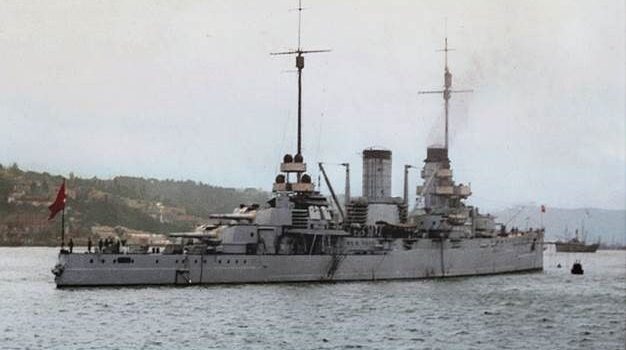
 Latest Facebook Entry -
Latest Facebook Entry -  X(Tweeter) Naval Encyclopedia's deck archive
X(Tweeter) Naval Encyclopedia's deck archive Instagram (@navalencyc)
Instagram (@navalencyc)





 French Navy
French Navy Royal Navy
Royal Navy Russian Navy
Russian Navy Armada Espanola
Armada Espanola Austrian Navy
Austrian Navy K.u.K. Kriegsmarine
K.u.K. Kriegsmarine Dansk Marine
Dansk Marine Nautiko Hellenon
Nautiko Hellenon Koninklije Marine 1870
Koninklije Marine 1870 Marinha do Brasil
Marinha do Brasil Osmanlı Donanması
Osmanlı Donanması Marina Do Peru
Marina Do Peru Marinha do Portugal
Marinha do Portugal Regia Marina 1870
Regia Marina 1870 Nihhon Kaigun 1870
Nihhon Kaigun 1870 Preußische Marine 1870
Preußische Marine 1870 Russkiy Flot 1870
Russkiy Flot 1870 Svenska marinen
Svenska marinen Søværnet
Søværnet Union Navy
Union Navy Confederate Navy
Confederate Navy Armada de Argentina
Armada de Argentina Imperial Chinese Navy
Imperial Chinese Navy Marinha do Portugal
Marinha do Portugal Mexico
Mexico Kaiserliche Marine
Kaiserliche Marine 1898 US Navy
1898 US Navy Sovietskiy Flot
Sovietskiy Flot Royal Canadian Navy
Royal Canadian Navy Royal Australian Navy
Royal Australian Navy RNZN Fleet
RNZN Fleet Chinese Navy 1937
Chinese Navy 1937 Kriegsmarine
Kriegsmarine Chilean Navy
Chilean Navy Danish Navy
Danish Navy Finnish Navy
Finnish Navy Hellenic Navy
Hellenic Navy Polish Navy
Polish Navy Romanian Navy
Romanian Navy Turkish Navy
Turkish Navy Royal Yugoslav Navy
Royal Yugoslav Navy Royal Thai Navy
Royal Thai Navy Minor Navies
Minor Navies Albania
Albania Austria
Austria Belgium
Belgium Columbia
Columbia Costa Rica
Costa Rica Cuba
Cuba Czechoslovakia
Czechoslovakia Dominican Republic
Dominican Republic Haiti
Haiti Hungary
Hungary Honduras
Honduras Estonia
Estonia Iceland
Iceland Eire
Eire Equador
Equador Iran
Iran Iraq
Iraq Latvia
Latvia Liberia
Liberia Lithuania
Lithuania Mandchukuo
Mandchukuo Morocco
Morocco Nicaragua
Nicaragua Persia
Persia San Salvador
San Salvador Sarawak
Sarawak Uruguay
Uruguay Venezuela
Venezuela Zanzibar
Zanzibar Warsaw Pact Navies
Warsaw Pact Navies Bulgaria
Bulgaria Hungary
Hungary

 Bundesmarine
Bundesmarine Dutch Navy
Dutch Navy Hellenic Navy
Hellenic Navy Marina Militare
Marina Militare Yugoslav Navy
Yugoslav Navy Chinese Navy
Chinese Navy Indian Navy
Indian Navy Indonesian Navy
Indonesian Navy JMSDF
JMSDF North Korean Navy
North Korean Navy Pakistani Navy
Pakistani Navy Philippines Navy
Philippines Navy ROKN
ROKN Rep. of Singapore Navy
Rep. of Singapore Navy Taiwanese Navy
Taiwanese Navy IDF Navy
IDF Navy Saudi Navy
Saudi Navy Royal New Zealand Navy
Royal New Zealand Navy Egyptian Navy
Egyptian Navy South African Navy
South African Navy






























 Ukrainian Navy
Ukrainian Navy dbodesign
dbodesign